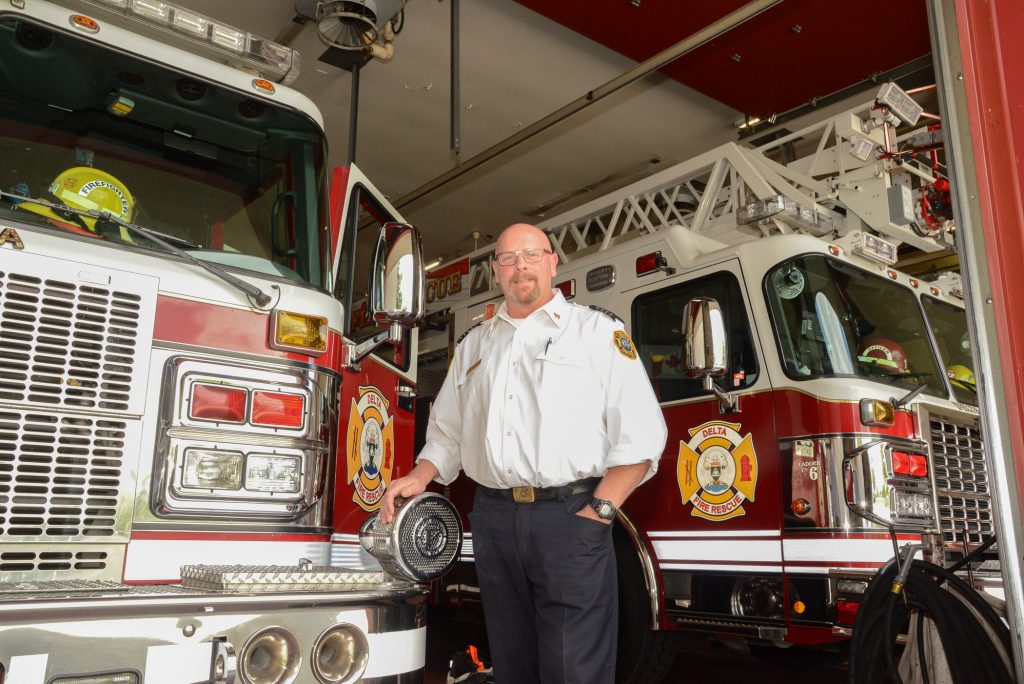

Delta: July 3 was a beautiful summer Sunday in the Lower Mainland of BC, so when a gigantic cloud of almost nuclear proportions erupted into the clear sky it commanded everyone’s attention. I was in Cloverdale that morning when I heard people wondering aloud what was going on.
Having seen the bog fire of 2005, I was pretty certain we were seeing it unfolding again, almost eleven years later.
Despite a fast response by the Delta Fire Service, the fire which was estimated by the Incident Commander, first on the scene, at about 100 metres square. It grew at an alarming rate until almost the whole Delta Fire Service was committed to fighting it along with the BC Forest Service and crews from Metro Vancouver Regional District.
Although the 2005 fire was 200 ha, the 78-hectare fire was spectacular and dangerous given the strong winds that were blowing that morning.
The fire is thought to be out, thermal imaging and surveillance continues in case any hot spots remain.
A look back at the event: Ray Hudson spoke with the Deputy Chief of Operations, Brad Wilson.
Wilson: At approximately 11:40 am, dispatch alerted us that there was smoke in the area of 72nd Street and Highway 17. Engine Seven from the Tilbury firehall was dispatched. When they arrived on scene they found the fire was about 100 metres by 100 metres. Around noon, they activated a First Alarm, which brought out Engine One, Battalion One, Engine Two and Engine Three, from Tsawwassen and Ladner as well as hall Three in North Delta.
Then, as part of the Burns Bog Management Plan, the Captain on Engine Seven, the Incident Commander, briefed Chief Dan Copeland who notified the BC Forest Service for aerial support, and Metro Vancouver for wildfire crews.
Shortly after that, a second alarm was called which added Engines Five and Six. By that time we were pretty tapped out. We had a couple of trucks left and some call-out firefighters, who made their way to Number One hall in Ladner. Later in the afternoon, still in the height of the bog fire, we had a structure fire happen along River Road West. We were able to dispatch those last two trucks to that fire. We were very challenged at that point.

Hudson: How many people were involved in fighting the fire?
Wilson: We had approximately 100 firefighters from Delta, Metro Vancouver Regional District, and the Ministry of Forests.
New Westminster, Richmond and Surrey were also involved. When we get all our trucks deployed on a large event like this, it really impacts our ability to respond to emergencies in Delta, so I contacted Surrey Fire to be on standby for North Delta, New Westminster moved one of their trucks with four crew into our Annacis Island Hall, and I called a truck with four firefighters from Richmond, to our main hall in Ladner. That was just for a short time, but the New West crew was in the Annacis hall for about eight hours. Even when they went back to their own halls they stayed on standby in case something big happened, such as a big motor vehicle incident or a fire elsewhere in Delta. I also contacted BC Ambulance Service to let them know that we would be limited in what medical calls we could respond to in our area.
Hudson: It’s good to know that when the department is busy there are still emergency responders to back you up.
Wilson: It’s a mutual aid agreement we have with our neighbours, which works very well. It goes two ways because we’ve supported their communities in times of need as well.
Hudson: In an incident such as this, who runs the show? Is it our Chief, Dan Copeland?
Wilson: Delta Chief Copeland was the Incident Commander on site, and once Forestry got there it turned into a unified command. Also in the chain was the Operations Deputy Chief, Guy McKintuck, who was in charge of working with the team and setting out the responses. I was in Emergency Operations Centre in the City Hall. The Ministry of Forests has a system where they have what’s called a Bird Dog airplane, which directs and coordinates the aircraft fighting the fire. They of course work with the Incident Command by Radio.
Hudson: What were the biggest challenges in fighting this fire?
Wilson: Being summertime, we had a lot of our people on holidays. The temperature wasn’t a problem, but the wind was a big challenge. We had high winds that day as well, lots of dry fuel on the surface, and then the wind changed direction and started pushing the fire in the direction of the Tilbury Industrial Park. That was a big concern. It was at that time we split our crews. The Delta crews left the bog fire to Metro Vancouver and the Ministry of Forests, and we set up a line to try and prevent the fire from jumping Highway 17 into our industrial area. It jumped the highway at 80th Street, as wide as it was, and ran up the knoll. It was a concern because it was very close to a big lumber yard, and a chemical storage plant. There were lots of potential for problems had we not stopped it, but our crews worked very hard and ultimately succeeded.
Initially, we thought Highway 17 would be a pretty good firebreak but obviously with the winds and fire’s intensity it managed to jump over.












